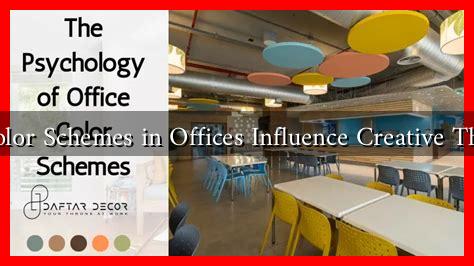-
Table of Contents
Can Color Schemes in Offices Influence Creative Thinking?
In the modern workplace, the design of office spaces has evolved significantly, with a growing emphasis on creating environments that foster creativity and productivity. One of the most intriguing aspects of office design is the use of color schemes. Research suggests that colors can have profound psychological effects on individuals, influencing mood, behavior, and even cognitive processes. This article explores how color schemes in offices can influence creative thinking, supported by studies, examples, and expert opinions.
The Psychology of Color
Color psychology is the study of how colors affect human behavior and emotions. Different colors can evoke various feelings and responses, which can be particularly relevant in a work environment. Here are some common associations with colors:
- Blue: Often associated with calmness and stability, blue can enhance focus and productivity.
- Red: This color can stimulate energy and passion but may also lead to increased anxiety if overused.
- Green: Linked to nature, green promotes relaxation and can enhance creative thinking.
- Yellow: A bright and cheerful color, yellow can inspire optimism and creativity but may be overwhelming in large doses.
- Purple: Often associated with luxury and creativity, purple can stimulate imaginative thinking.
How Color Schemes Impact Creativity
Research indicates that the right color scheme can significantly enhance creative thinking in the workplace. A study published in the journal *Color Research and Application* found that individuals working in environments with stimulating colors, such as yellow and green, performed better on creative tasks compared to those in more neutral settings. Here are some ways color schemes can influence creativity:
- Emotional Response: Colors can evoke emotional responses that may either hinder or enhance creative thinking. For instance, a vibrant workspace can energize employees, leading to more innovative ideas.
- Associative Thinking: Certain colors can trigger associations that facilitate brainstorming and idea generation. For example, a blue environment may encourage analytical thinking, while yellow may promote free-flowing ideas.
- Collaboration: Colorful spaces can foster a sense of community and collaboration among employees, encouraging them to share ideas and work together creatively.
Case Studies and Real-World Examples
Several companies have successfully implemented color schemes to enhance creativity in their offices. For instance:
- Google: Known for its vibrant office designs, Google uses a variety of colors throughout its workspaces to stimulate creativity and innovation. The playful use of color encourages employees to think outside the box.
- Airbnb: The company’s headquarters features bright colors and open spaces that promote collaboration and creative thinking. The design reflects the brand’s ethos of community and innovation.
- Dropbox: Dropbox’s office incorporates calming blues and greens, creating an environment that fosters focus and creativity, allowing employees to engage in deep work.
Statistics Supporting Color Influence
Several studies have quantified the impact of color on workplace productivity and creativity:
- A study by the University of Texas found that employees in colorful environments were 15% more productive than those in dull settings.
- According to a survey by the Institute for Color Research, people make a subconscious judgment about a person, environment, or product within 90 seconds of initial viewing, with color being the primary factor in that judgment.
Conclusion
In conclusion, the color schemes used in office environments can significantly influence creative thinking and overall productivity. By understanding the psychological effects of colors and strategically implementing them in workplace design, companies can create spaces that not only enhance creativity but also improve employee satisfaction and collaboration. As organizations continue to prioritize innovative thinking, the role of color in office design will undoubtedly remain a critical factor in shaping the future of work.
For further reading on the impact of color in design, you can explore resources from the Color Psychology website.


